Bear Habitat Map
This map shows the overlapping habitats of Polar, Brown, Black, Sun, Panda, Spectacled, Asian, and Sloth Bears. The ring around the images has the colors of the different ecoregions, each species occupies. Due to range overlapping, a single species might have more than one color. Each image is a button that you can select to pick the distribution of a particular species. Zoom in the map to take a closer look! Hover to get the name of the ecoregion. For more information scroll down.
Bear Habitat and Distribution
Bears belong to the family Ursidae. They are a small group of mostly large mammals, with 8 species in 5 genera. Although Ursidae is not diverse, species in this family are widespread.
They are found on all continents except Antarctica and Australia. Their range has been reduced as a result of human persecution and habitat destruction.
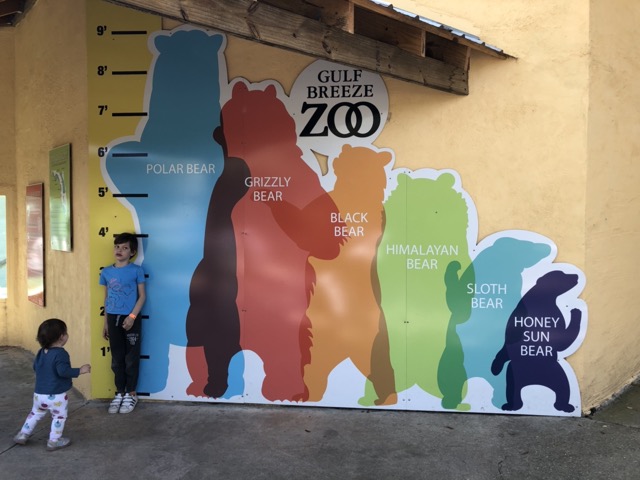
Bears occur in nearly all terrestrial habitats throughout their range, from Arctic tundra and polar ice, to tropical and temperate forests, mountains, grasslands, and deserts.
Although some bear species occur in arid areas, proximity to water is important. Bears are most abundant and diverse in temperate and boreal regions. Animal Diversity Web.
As shown in this map, Bears live in the following regions:
- Polar Bears live in the Arctic.
- Brown Bears live in North America, Russia, Northern Europe, Himalayas, Alps, and Shrublands of the Middle East.
- Black Bears live in North America.
- Spectacled Bears live in the South American Andes mountains.
- Panda Bears live in Mountains of Central China.
- Sloth Bears live in Eastern India.
- Sun Bears live in South East Asia.
- The Asian Bear lives scattered through Central China, North West of India, North Korea, Japan, and Malaysia.
If you want to learn more about bears Amazon has Bears of North America: Black Bears, Brown Bears, and Polar Bears. In this book wildlife photographer and award-winning author Stan Tekiela takes you to the world of bears.
Bear Facts
Bears are omnivorous mammals divided into eight species and most of them are endangered. Did you know that to scratch their backs on their favorite trees, they walk for miles. These are some facts about Bears. Source: Serious Facts
- Bears eat mostly meat and fish, but some bears also eat plants and insects.
- Most bears have 42 teeth.
- Even though bears are big and heavy, they can run very fast.
- Bears are good at climbing and swimming.
- A group of bears is called a sloth.
- Bears have a large brain and are also known as intelligent mammals.
- Unlike many mammals, bears can see in color.
- A male bear is called a boar and female is called sow.
- Bears have an excellent sense of smell, better than dogs.
Polar Bear or Ursus maritimus

Polar bears live on sea ice, where they hunt seals at open leads. Polar bears are found in five countries across the Arctic: the U.S. (Alaska), Canada, Russia, Greenland, and Norway.
"Polar bears are classified as marine mammals because they spend most of their lives on the sea ice of the Arctic Ocean.
They have a thick layer of body fat and a water-repellant coat that insulates them from the cold air and water. Their coat is white to camouflage with the surrounding ice.
Considered great swimmers, Polar Bears can keep a pace of six miles per hour by paddling with their front paws and holding their hind legs flat like a rudder.

Polar bears spend over half of their time hunting for food. A polar bear might catch only one or two out of ten seals it hunts, depending on the time of year and other variables. Their diet mainly consists of ringed and bearded seals because they need large amounts of fat to survive.
Because of ongoing and potential loss of their sea ice habitat resulting from climate change, polar bears were listed as a threatened species in the US under the Endangered Species Act in May 2008." Source: World Wildlife Fund.
Wapusk National Park in Ontario, Canada, is a broad wilderness area in the remote subarctic. This park is at the transition between the arctic tundra and boreal forest. Wapusk protects one of the largest polar bear maternity den areas in the world!
Brown Bear or Ursus arctos

Grizzly or Brown Bear is a bear species found across Eurasia and North America. Brown bears can be found in many habitats, from deserts to high mountain forests and ice fields.
In Europe, brown bears are found in mountain woodlands, in Russia they occur primarily in forests while in North America they prefer tundra, alpine meadows and coastlines.
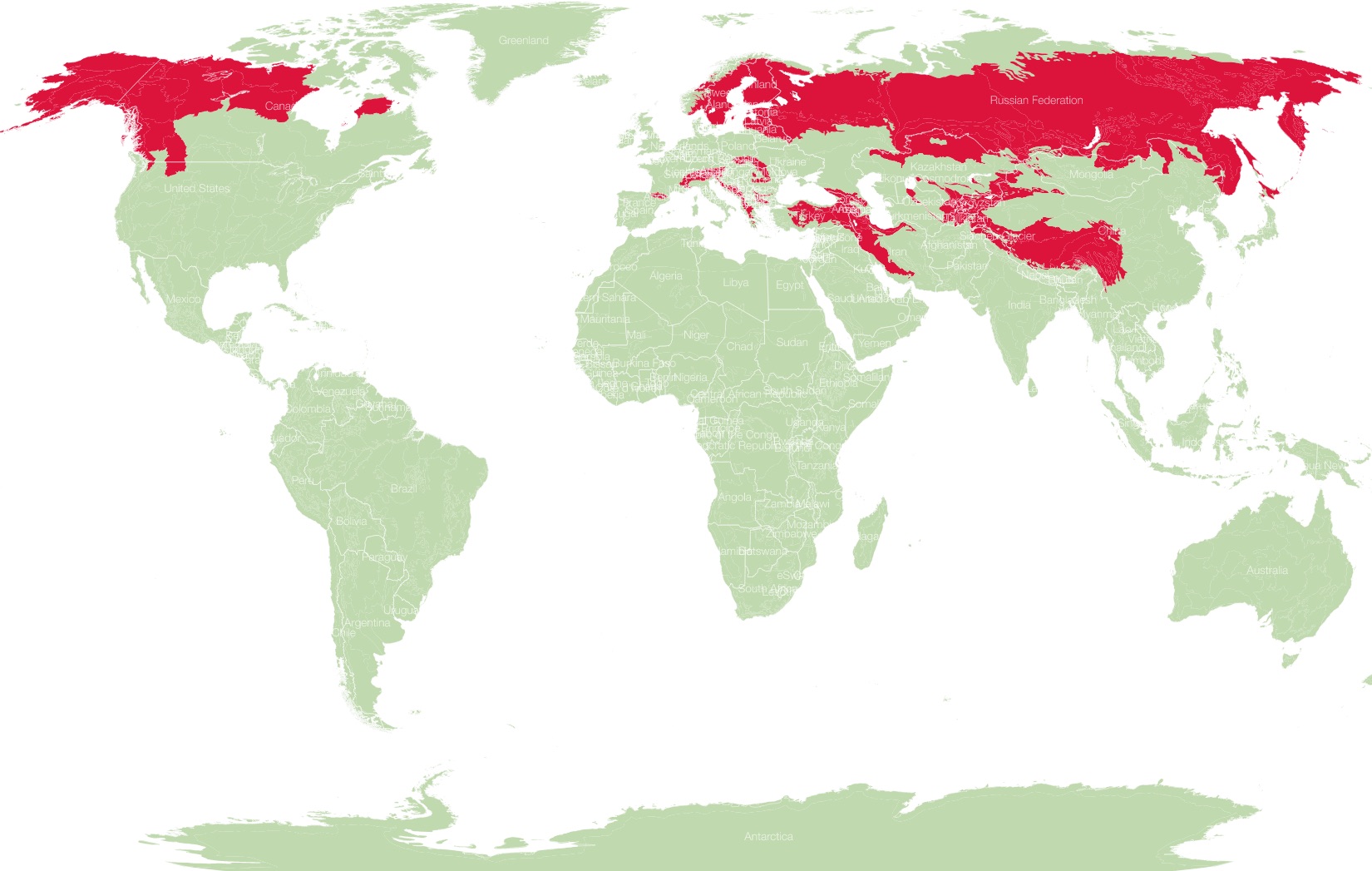
Brown bears are divided into many subespecies throught Eurasia and America.
These subspecies are: Eurasian, Kamchatkan, Siberian, Gobi, Himalayan, Ussuri, Marsican, Tibetan Blue Bear, Cantabrian, Syrian, Grizzly, Alaskan, Kodiak, Mexican Grizzly, and Sitka Brown Bears.
Brown bears feed on berries roots, bulbs of plants, ground dwelling rodents, and most importantly whitebark pine nuts, moose, elk, mountain goats and mountain sheep, and salmon.
Grizzlies range in color from white, blonde, brown, black and shades thereof.
The tips of most fur are lighter in color giving them a grizzled effect.
In general, brown bears will flee as soon as they detect humans.
Finding food, finding mates, and avoiding being preyed upon govern a brown bear’s life. Link: Bear Center.
According to Red List, Brown bears are of least concern.
American Bear, Black Bear or Ursus americanus

Black Bears are North America's most familiar and common bears. They typically live in forests and are excellent tree climbers, but are also found in mountains and swamps.
Despite their name, black bears can be blue-gray or blue-black, brown, cinnamon, or even (very rarely) white.
Black bears are very opportunistic eaters. Most of their diet consists of grasses, roots, berries, and insects. They will also eat fish and mammals including carrion, and easily develop a taste for human foods and garbage.
Bears who become habituated to human food at campsites, cabins, or rural homes can become dangerous and are often killed, thus the frequent reminder: Please don't feed the bears!
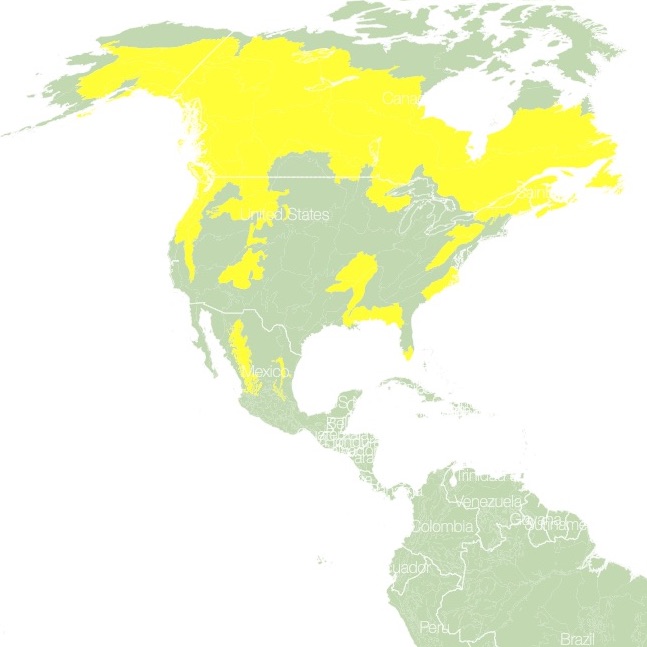
When winter arrives, black bears spend the season dormant in their dens, feeding on body fat they have built up by eating ravenously all summer and fall. They make their dens in caves, burrows, brush piles, or other sheltered spots, sometimes even in tree holes high above the ground.
Female black bears give birth to two or three blind, helpless cubs in mid-winter and nurse them in the den until spring, when all emerge in search of food.
The cubs will stay with their very protective mother for about two years. Source: National Geographic.
Andean bear, Spectacled bear, Oso de Anteojos or Tremarctos ornatus

The bears are native to Andean countries from Venezuela to Bolivia, living in forests, grasslands, and scrublands.
Wild Andean bears are omnivores, known to eat more than 300 plant species and over 20 animal species. The most common items in their diet appear to be plants, especially fruits, palms, and bromeliads.
Bears living in scrubland habitat are even known to seek out snails and to eat cacti!

Sometimes these bears feed on dead livestock and they will sometimes hunt cattle, which causes conflict with local farmers. The bears also pose challenges for local people when the bears raid cornfields. Source: San Diego Zoo. According to Red List Spectacled bears are Vulnerable.

Their name is attributed to the rings of white or light fur around its eyes, which can look like eyeglasses (or spectacles) against the rest of the bear’s black or dark brown fur.
Andean bears are thought to use vocal communication more than any other bear except the giant panda. They make unique vocalizations that are quite "un-bear-like": a shrill screech and a soft, purring sound. Mother bears may use different vocalizations to communicate with their cubs.
Although the Spectacled bear is typically diurnal, very little is known about them in the wild, as they are shy and tend to avoid humans, making them hard to find for researchers to study!
Labiated Bear, Sloth Bear or Melursus ursinus

The habitat of Labiated Bears range from wet and dry tropical forests, scrublands, savannas, and grasslands. Wikipedia
Sloth bears are unique looking bears. These are mostly black bears with a V or Y whitish cream marking on the chest. The fur is long and shaggy. The long muzzle is also pale in color, mostly due to lack of fur in that area.
Sloth bears have very long, flexible lips that are adapted for their diet of insects. They have very long claws for digging.
Sloth bears are sometimes also called honey bears or lip bears. This species has the ability to close its nostrils so ant, termites, dirt, or bees do not get into their nose. Their diet consists of fruits, ants, termites, honeycombs, and other insects. These are medium size bears at about 5-6 feet long.

Sloth bears are solitary creatures, living alone except during breeding season. Sloth bears are the only bear species known for carrying their cubs on their back!
They are generally nocturnal, especially when living in an area near humans. These bears have been seen climbing high up trees to knock down honeycombs.
Sloth bears will stand on their hind legs and vocalize if threatened. They are not afraid to defend themselves against tigers, leopards, or humans.
The character Baloo in The Jungle Book is based on a sloth bear. Source: San Diego Zoo. According to Red List their conservation status is Vulnerable.
Giant Panda or Ailuropoda melanoleuca

"Pandas live mainly in temperate forests high in the mountains of southwest China, where they subsist almost entirely on bamboo". WWF
Native to central China, giant Pandas have come to symbolize vulnerable species. As few as 1,864 giant pandas live in their native habitat, while another 600 pandas live in zoos and breeding centers around the world.
Although scientists do not know why these unusual bears are black and white, some speculate that the bold coloring provides effective camouflage.
The giant panda has lived in bamboo forests for several million years. It is a highly specialized animal, with unique adaptations for its diet. The panda's thick, wooly coat keeps it warm in the cool forests and mountains.
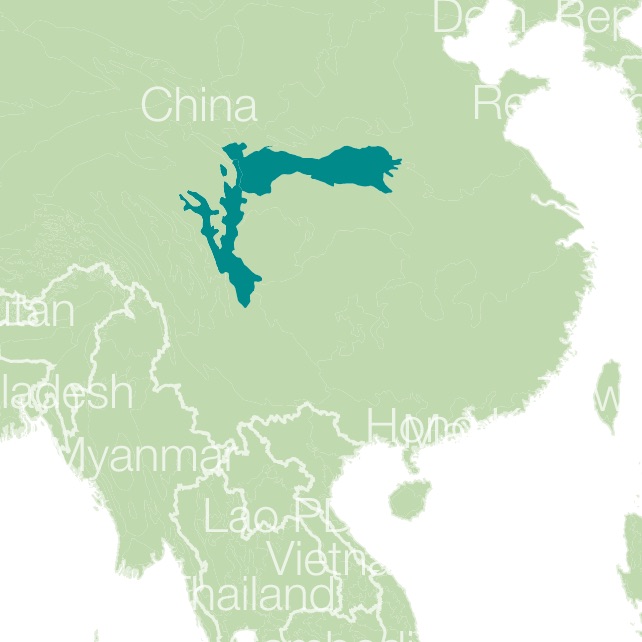
Giant pandas have large molar teeth and strong jaw muscles for crushing tough bamboo. Many people find these chunky, lumbering animals to be cute, but giant pandas can be as dangerous as any other bear.
Adult giant pandas may be solitary, but they do communicate periodically through scent marks, calls and occasional meetings.
Recent research has also found that giant pandas may form communities of seven to 15 individuals within the local population.
Giant pandas reach breeding maturity between four and eight years of age. They may be reproductive until about age 20.
Female pandas ovulate only once a year, in the spring. A short period of two to three days around ovulation is the only time a giant panda is able to conceive. Link: Smithsonian's National Zoo. According to Red List their conservation status is Vulnerable.
For more facts about bear Amazon has Bear Almanac: A Comprehensive Guide To The Bears Of The World. This book collects what is known about the world's bears, presenting in words and gorgeous photographs, a complete factual compendium of bear knowledge for the amateur naturalist and the bear specialist alike.
Sun Bear or Helarctos malayanus

"Lives in Southeast Asian tropical forests, including tropical evergreen rainforest, montane forest, and swamp habitat" Panda.org
Malayan Bear or Sun Bear are the smallest living bear species, weighing just 35-80 kilograms (75 – 175 pounds). Still, this little omnivore possesses a big appetite, feeding on anything from fruit to termites; from earthworms to eggs, turtles, birds and beetle larvae.
Their tongues may measure 18 inches, the longest for any bear, enabling them to dexterously delve into tree trunks and steal honey straight from the hive.
A 2015 study found that 46 percent of farmers in west-central Sumatra had experienced conflict with Sun bears, mostly due to crop raiding.
Its range once extended across mainland Southeast Asia, to Sumatra and Borneo, but the animal now occurs only patchily throughout.

The Sun Bear is threatened by habitat loss and hunting for traditional medicine.
Sun bears are a keystone species, vitally important for seed dispersal, pest control and nutrient cycling. Their extinction would likely bring major, though largely unstudied, impacts to tropical forests.
Conservationists in Indonesia and elsewhere are studying Sun bear behavior to improve rescue and restoration efforts. Others want to eliminate commercial bear farms where bear bile is extracted, and end trafficking by creating strong national legislation, improving enforcement, and raising public awareness. Source: Mongabay News. According to Red List their conservation status is Vulnerable.
Asiatic Black Bear orUrsus thibetanus

Asiatic Black bear, Moon bear and White-chested bear are found over a wide area of southern Asia. They live predominantly in forested areas, especially in hills and mountainous areas.
In summer, they have been reported at altitudes over 3,000 meters (9,900 feet), descending to lower elevations during winter. Apparently, they den for winter sleep in the northern parts of their range.
It has been suggested that in the southern limits of their range, where it is quite hot, they do not undergo winter sleep, but this has not been confirmed.
In Russia, the home range is reported to be 10 to 20 square kilometers (4 to 8 square miles). Nathab
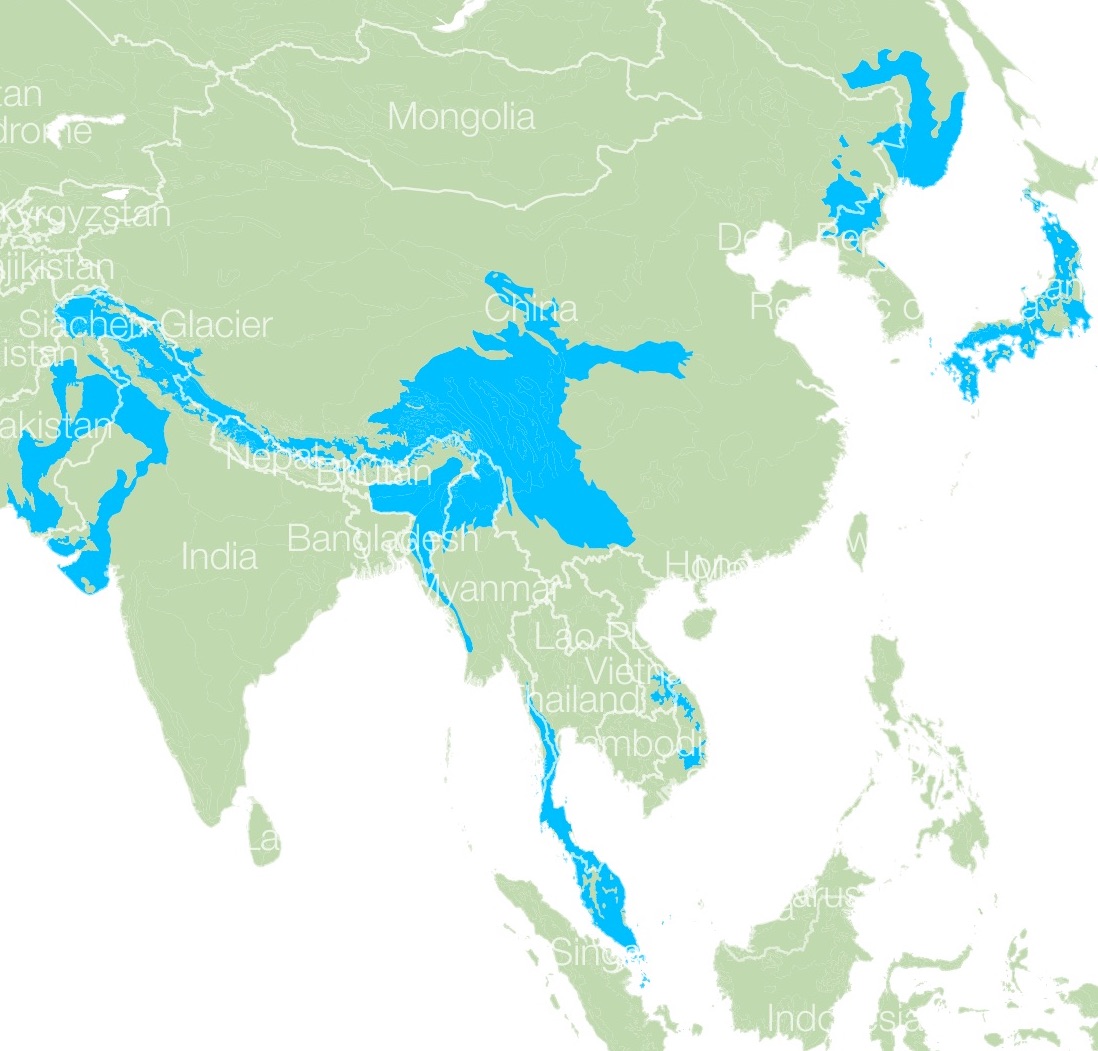
Little information is available on social organization of Moon Bears. The bears are reported to be mainly nocturnal, sleeping in trees or caves during the day. Asiatic black bears have been reported to feed on a wide range of foods, including fruits, bees' nests, insects, invertebrates, small vertebrates, and carrion.
They occasionally kill domestic livestock, but the degree to which they prey on wild hoofed mammals in unknown. In fall they frequently make crude leafy feeding platforms in nut-bearing trees. Bear Biology. According to Red List their conservation status is Vulnerable.
Inspiration for Bears Habitat Map
This map was inspired by headlines about bears I have read on the news, or found on social media. There is no way not to feel attracted to the reports on these adorable creatures.
I grew up listening to stories about Spectacled Bears entering people's properties in the cold páramos and Bogotá's surrounding mountains. The accounts of the locals, almost made it believe bears are not compatible with modern settlements.
Later I started following the fate of Polar Bears and the reduction of Arctic sea ice. This dire situation has left Polar Bears to starve, as their habitat keeps shrinking and their chances to feed reduced.
More recently I discovered that part of the success protecting Giant Pandas and reproducing them, is the attention they get. This is thanks to their cute looks and adorable photos!
Unfortunately this is not enough to keep most bears out of negative attention and habitat deterioration.
With this map I wanted to know: Where do bears live? What is a bears' habitat? Where does the Grizzly bear live? Do bear habitats overlap?
Resources for Bear Distribution Map
Regardless of the distribution shown here, most of it is probable, since most of their natural habitat is scattered or affected by human populations.
I used http://www.katblackdesign.com/bear-infographic as a base map and inspiration for the Bear habitat map design. Polar bear population and territory came from Carbon Brief.
The shapefiles to create the map with ecoregions of the world were obtained from WWF.
The shapefiles with the countries of the world were obtained from Natural Earth.
The range of brown bear over America and Eurasia was compiled in Status Report on the Grizzly Bear. The American Black bear habitat was obtained from Bear.org. The habitat of the spectacled bear was retrieved from Earth Touch. To find the homeland of the Giant Panda I used the maps from China Highlights.
The current geographic range of Sloth Bear was obtained from IUCN Red List. The habitat map of the Sun bear was referenced from Short Communication on TRAFFIC.
This map will be updated with improved and recent information! To receive updates on this and more nature maps join my email list!!!!!!!
Made by Luz K. Molina with D3.js.









